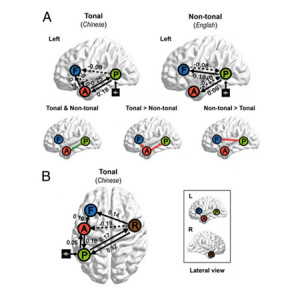A study has found that people who speak tonal languages such as Mandarin or Cantonese use both hemispheres of their brain rather than just the left hemisphere, which researchers have long emphasized as being the primary processing center for languages.
Quartz sorts out the report, which was recently published in the in the Proceedings for the National Academy of Science:
After analyzing brain imaging data from Mandarin and English speakers listening their respective languages, researchers from Peking University and other universities found that native Mandarin speakers and native English speakers both showed evidence of activity in the brain’s left hemisphere. But Mandarin speakers also saw activation in the right hemisphere, specifically in a region important for processing music, via pitch and tone, that has long been seen as largely unrelated to language comprehension.
Since at least the 1950s, researchers in the field of neurolinguistics have been questioning how languages influence perception, and physiological behavior. This latest study supports one emerging theory, connectionism, that maintains that some languages require interactions across the entire brain. The findings are important for better protecting language-related regions during brain surgery as well as understanding the “constitution of knowledge of language, as well as how it is acquired,” according to the study.
It can be reasonably concluded then that all native speakers of tonal languages, including Vietnamese, Cantonese and Thai, use more of their brain than non-tonal language speakers, Gang Peng, a co-author of the study, told Quartz. Bonus: these speakers are more likely to have perfect pitch.



